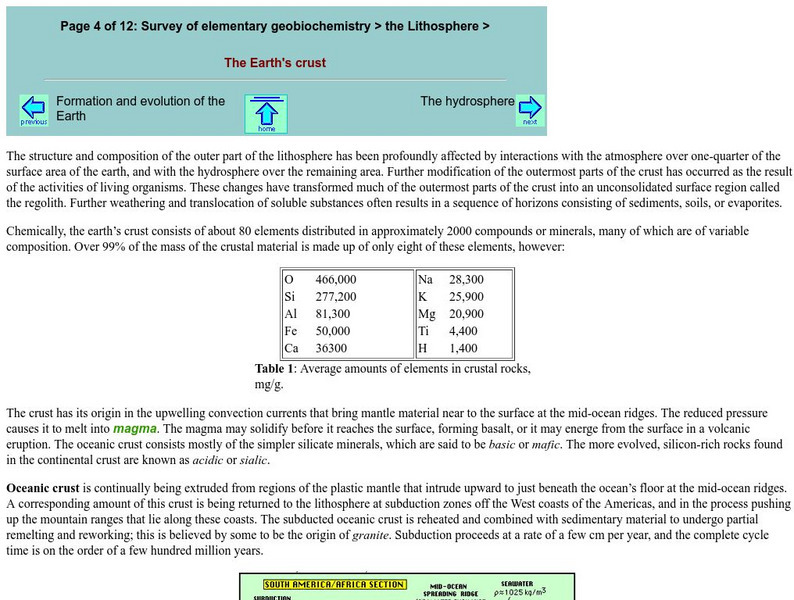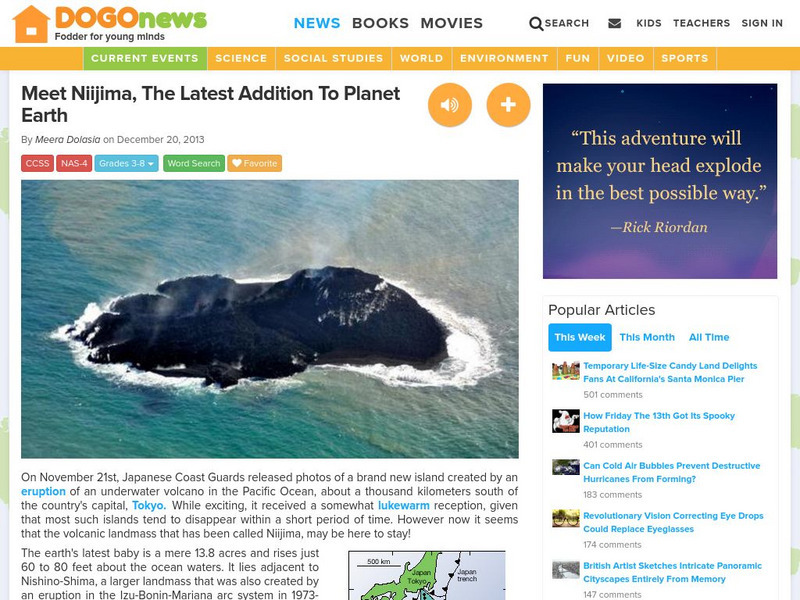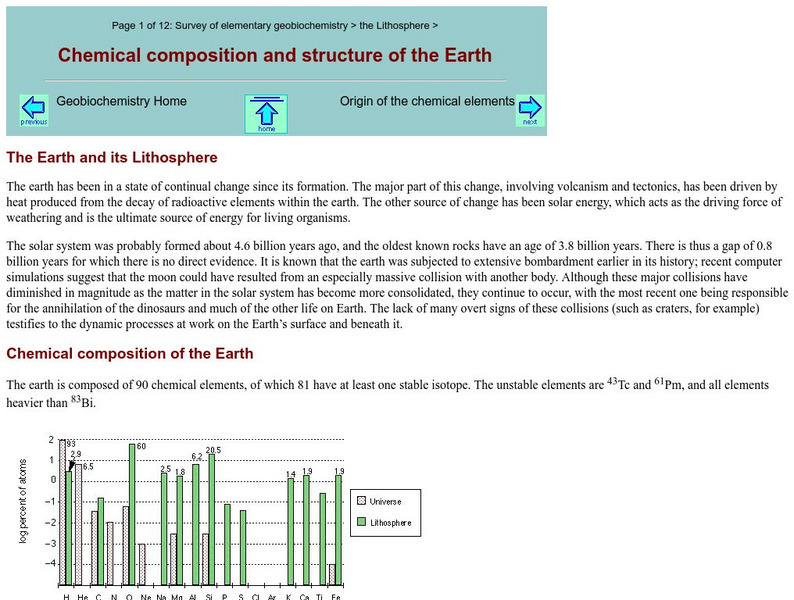Australian Museum
Structure and Composition of the Earth
What makes the Earth unique? What are the different parts of the Earth? What is the chemical make-up of the Earth? Get the answers to these questions and more on this site from the Australian Museum Online.
Globe
The Globe Program: All About Earth: Our World on Stage [Pdf]
This delightful storybook provides young learners an understanding of how the Earth's processes work together. The students of an elementary classroom have been making costumes and practicing lines. Each student is playing the role of a...
Other
Teaching the Jah: Earth Day and the Environmental Movement
As part of a larger lesson plan on the the environment and the environmental movement, this lesson focuses on the movement as part of a larger emphasis on social movements in the 1960s. Find information about the history of Earth Day,...
Other
Earth Day Network
The official online home of Earth Day offers many resources regarding environmental education. Includes the latest news on environmental advocacy and how to take part in Earth Day each year.
Simon Fraser University
Chem1 Virtual Textbook: The Earth's Crust
As part of the General Chemistry Virtual Textbook, this site examines a variety of topics related to the Earth, and specifically the Earth's crust. Other topics covered include chemistry of the crust, composition of rock, distribution of...
PBS
Pbs Learning Media: Earth's Water Movements
The paths that water can take through Earth's systems are many and complex. Examine the following diagram from NASA depicting the water cycle. Studying the water cycle is important because changes in the water cycle affect all parts of...
Annenberg Foundation
Annenberg Learner: Earth & Space Science
This course is composed of eight sessions, each with a one-hour video program addressing a topic area in Earth and Space Science that emphasizes the science content that is likely to be part of any elementary school science curriculum.
Vision Learning
Visionlearning: Atmosphere and Oceans: Composition of Earth's Atmosphere
An explanation of the different parts of the atmosphere and how pressure and temperature changes at different altitudes.
DOGO Media
Dogo News: Week of 12 23 13: Meet Niijima, the Latest Addition to Planet Earth
Learn about the newest part of Earth, Japan's Niijima Island.
Science Education Resource Center at Carleton College
Serc: Earth System Science
Students learn to identify the parts of the Earth system and the processes that connect them. They look for interconnections among components of the Earth system at the local level, using a study site close to their school.
Curated OER
National Park Service: What on Earth Is Plate Tectonics?
An easy-to-understand explanation of what plate tectonics is. Contains information about the inner parts of the Earth, the difference between the three types of plates, and numerous maps and illustrations.
American Geosciences Institute
American Geosciences Institute: Earth Science Week: Global Change: Where Land, Air and Water Meet
To develop an understanding of parts per million as a concept, teams of young scholars create successive dilutions of a solution to reach a parts-per-million concentration.
Simon Fraser University
Chem1 Virtual Textbook: Chemical Composition and Structure of the Earth
As part of the General Chemistry Virtual Textbook, this site examines a variety of topics related to the Earth. This page looks at the Earth and its lithosphere, the chemical composition of the Earth, the structure of the Earth, and more.
Science Education Resource Center at Carleton College
Serc: Lab 7: A Year in the Life of the Earth System
An investigation that is part of a series of lab lessons that expose students to Earth Systems through research, data, and visualizations. In this lab, students will observe how the Earth has changed over time to understand the Earth as...
PBS
Pbs: Journey to Planet Earth: Land of Plenty, Land of Want
Part of the PBS series "Journey to Planet Earth," this site explores the "fundamental problem facing today's farmer: how to feed the world's growing population without endangering our environment." Includes video and educational resources.
Encyclopedia of Earth
Encyclopedia of Earth: Microbiology: Cells
Article describing the parts of a cell. Includes chart listing the main parts of a cell and their definitions. Discusses some of the ways a cell can become damaged. (Published: February 28, 2008)
PBS
Pbs Learning Media: Earth in Motion: Seasons
This interactive activity from the Adler Planetarium explains the "reasons for the seasons." Featured is a game in which Earth must be properly placed in its orbit in order to send Max, the host, to different parts of the world during...
PBS
Pbs: Journey to Planet Earth: On the Brink
A part of the PBS series "Journey to Planet Earth," this section examines "how severe environmental problems can lead to political crises and increased hostilities around the world." Includes video clips and educational resources.
PBS
Pbs: Journey to Planet Earth: Seas of Grass
A part of the PBS series "Journey to Planet Earth," this section explores the world's grasslands, some of which are in environmental danger. Includes video and educational resources.
Encyclopedia of Earth
Encyclopedia of Earth: Geology: Pliocene
Article describing the Pliocene Epoch, which lasted from 5.3 million to 1.8 million years ago, and was part of the Cenozoic Era. It covers subdivisions of the Pliocene, geology, and climate. (Published: January 20, 2010)
CK-12 Foundation
Ck 12: Earth Science: Continental Drift Part Ii Study Guide
This comprehensive study guide covers the main terms and concepts needed for an earth science unit on continental drift. Review questions are included at the bottom of the study guide. Part II of II.
CK-12 Foundation
Ck 12: Earth Science: Continental Drift Study Guide
This comprehensive study guide covers the main terms and concepts needed for an earth science unit on continental drift. Review questions are included at the bottom of the study guide. Part I of II.
Cornell Lab of Ornithology
Habitat Network: Habitat Feature: Bare Earth for Native Pollinators
Find out why keeping a part of your yard as bare ground is important for providing nesting habitat for native bees.
Wisc-Online
Wisc Online: Heat and Heat Transfer Part 1
Review heat and heat transfer by solving these seven phrases! Then move on to "Heat and Heat Transfer Part 2"















